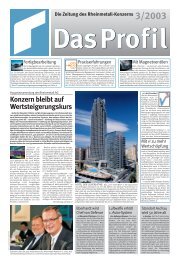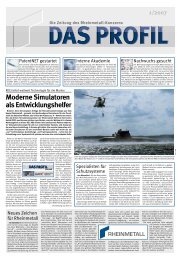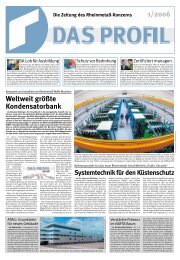PDF [1.6 MB] - Kolbenschmidt Pierburg AG
PDF [1.6 MB] - Kolbenschmidt Pierburg AG
PDF [1.6 MB] - Kolbenschmidt Pierburg AG
You also want an ePaper? Increase the reach of your titles
YUMPU automatically turns print PDFs into web optimized ePapers that Google loves.
he financial press regularly<br />
publishes lists of the<br />
100 biggest companies in<br />
Germany, sometimes<br />
measured in terms of<br />
sales, sometimes by market<br />
capitalization. Rheinmetall<br />
<strong>AG</strong>, too, features in these lists:<br />
for example, the corporation’s sales of<br />
€ 3.5 billion in 2005 prompted the<br />
Süddeutsche Zeitung, a prestigious<br />
Munich daily, to rank the company in<br />
95th place in June 2006.<br />
We are indebted to Economic Historian<br />
Martin Fiedler of the University of<br />
Bielefeld for the following finding, which<br />
appeared in 1999 in the “Zeitschrift für<br />
Unternehmensgeschichte”, a learned<br />
journal dedicated to corporate history:<br />
as far back as 1907, exactly a hundred<br />
years ago, Rheinmetall numbered<br />
among the top 100 companies of the<br />
German Reich – measured, that is, by<br />
headcount. Unlike parameters such as<br />
sales, cash flow, market capitalization<br />
or nominal capital, the number of employees<br />
– especially if one wishes to<br />
compare the size of a company over a<br />
period of a hundred years or more – is<br />
an indicator “which in a sense is timeless<br />
and requires no elaborate methods<br />
of conversion”.<br />
When we look at the numbers employed<br />
by the 100 largest companies in<br />
Germany in 1907, it is striking how<br />
great the gap is between the very<br />
largest German corporations and<br />
Rheinische Metallwaaren- und Maschinenfabrik<br />
(Rheinmetall’s predecessor),<br />
which ranked 98th on the list. At the<br />
very top are two state-owned enterprises:<br />
the Prussian-Hessian Railway with<br />
486,381 employees, and the Deutsche<br />
Reichspost with “only” around half as<br />
many (277,116). Ranking third and<br />
sixth, respectively, come the first private-sector<br />
companies: Krupp in Essen<br />
with a workforce of 64,354, and<br />
Newsline<br />
In 1907, exactly a hundred years ago, Rheinmetall already numbered among the top 100 companies of the former German Reich.<br />
Siemens & Halske and the Siemens-<br />
Schuckertwerke in Berlin, which together<br />
employed 34,324.<br />
And Rheinmetall? The annual report<br />
for 1907 puts the number at 3,048<br />
workers, who earned an average of<br />
4.68 Reichsmarks per shift (in those<br />
days the money was better at Krupp!).<br />
Rheinmetall also employed a thousand<br />
or so Privatbeamte (literally “private<br />
civil servants”), as salaried workers<br />
were then known. Founded just 18<br />
years earlier, Rheinmetall could not<br />
compare with giants like Krupp and<br />
Siemens, but it was already on a par<br />
with many companies that are still<br />
household names to this day: Thyssen<br />
& Co. (steel) in Mülheim, Farbwerke<br />
Hoechst (dyes), die Gewerkschaft Zollverein<br />
(coalmining), the German-Austrian<br />
Mannesmannröhrenwerke (pipes),<br />
Blohm & Voss (shipbuilding), WMF (cut-<br />
lery and tableware), Buderus (casting),<br />
to say nothing of Deutsche Bank, the<br />
most capital-rich company of the age.<br />
All of these companies had workforces<br />
numbering roughly 4,000 in 1907.<br />
A hundred years ago Rheinmetall was<br />
still far from being a management holding<br />
company. In 1907 the company had<br />
four production plants, including two<br />
in Düsseldorf-Derendorf – the recently<br />
rebuilt-on site of former Werk 1 and the<br />
Germania factory directly across from<br />
it, now occupied by a DaimlerChrysler<br />
plant – as well as the steelworks in<br />
Düsseldorf-Rath and the former<br />
Dreyse-Werk at Sömmerda, faraway in<br />
Thuringia. The firing range in Unterlüß<br />
was in Rheinmetall hands by this point<br />
too. The company owned no subsidiaries,<br />
though it did have a number<br />
of minority holdings: the Reisholz pipe<br />
plant in Düsseldorf-Reisholz, originally<br />
founded in 1899 by Heinrich Ehrhardt<br />
as Press- und Walzwerk <strong>AG</strong>, and now<br />
part of Mannesmannröhren-Werken.<br />
Rheinmetall also had an equity partici-<br />
19<br />
pation “in a foreign plant for producing<br />
steel and war material”. An intriguing<br />
detail, but the annual reports published<br />
in this period unfortunately<br />
make no mention of the name or location<br />
of this mysterious plant.<br />
In his article in the “Zeitschrift für Unternehmensgeschichte”,<br />
Martin Fiedler<br />
rightly notes the many gaps in studies<br />
of this kind. Indeed, in a table produced<br />
by Fiedler himself relating to a<br />
later period (1938), Rheinmetall-Borsig<br />
is missing. The merger with Borsig-<br />
Werk in Berlin in 1936 nearly doubled<br />
the number of Rheinmetall employees<br />
compared to 1935. By 1938, with a<br />
workforce of 45,438 – the figure cited<br />
in that year’s annual report – the muchenlarged<br />
company had clearly joined<br />
the ranks of Germany’s corporate giants:<br />
a fact which escaped Fiedler’s attention.<br />
In 1907 already in the top 100<br />
The Reichsbahn and Reichspost (the<br />
state railway company and the postal<br />
service) remained unchallenged as the<br />
nation’s largest employers, followed by<br />
the artificially created industrial conglomerates<br />
IG Farben and Vereinigte<br />
Stahlwerke, trailed in turn by Siemens,<br />
Krupp, Gutehoffnungshütte (another<br />
Ruhr Valley heavy engineering company),<br />
the Veba energy concern, Friedrich<br />
Flick KG, AEG and Reichswerke Hermann<br />
Göring. Then, in 12th place,<br />
would have come Rheinmetall-Borsig<br />
<strong>AG</strong>, which – in contrast to 1907 – had<br />
since grown into a massive industrial<br />
concern. Apart from plants in Berlin-<br />
Tegel, Düsseldorf, Sömmerda and<br />
Unterlüß, “Rheibo” had major subsidiaries<br />
and trade investments, especially<br />
in Berlin; but the company maintained<br />
large-scale production facilities<br />
in Switzerland and the Netherlands as<br />
well. To this extent, Rheinmetall-Borsig<br />
in 1938 was even bigger than Röchling,<br />
Rheinmetall’s later majority shareholder.<br />
Dr. Christian Leitzbach


![PDF [1.6 MB] - Kolbenschmidt Pierburg AG](https://img.yumpu.com/8657804/19/500x640/pdf-16-mb-kolbenschmidt-pierburg-ag.jpg)
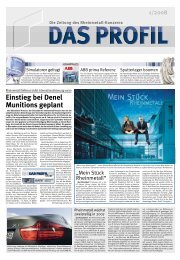



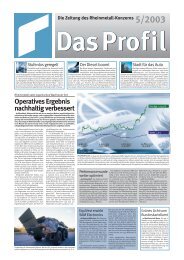
![PDF [2.4 MB] - Kolbenschmidt Pierburg AG](https://img.yumpu.com/8295864/1/184x260/pdf-24-mb-kolbenschmidt-pierburg-ag.jpg?quality=85)
![PDF [2.5 MB] - Kolbenschmidt Pierburg AG](https://img.yumpu.com/8112793/1/184x260/pdf-25-mb-kolbenschmidt-pierburg-ag.jpg?quality=85)




